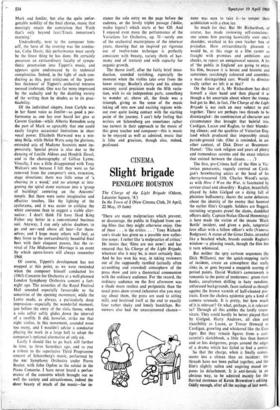Faith beyond fear
OPERA EDWARD BOYLE
I never saw the original production of Tippett's The Midsummer Marriage in 1955. But I came away from last week's first night at Covent Garden feeling that the evening had been a really deep musical experience, and that I hope very greatly to go again before the present run comes to' an end.
Of course, this is a difficult and, sometimes, perplexing work, with the dramatic interest (especially in Act 1) unevenly sustained. The composer has taken enormous risks, and there are moments when the libretto seems fatally to impede the realisation of his vision. And yet the overall impression, after all one's reserva- tions had been allowed for, was of a truly great achievement; this is a new, exciting world of sound, by turns blissful and com- passionate, vibrant and heart-easing, bearing all the marks of creative imagination at white heat. As I write, I remember most vividly, first, the glory of the transfigured Jenifer's music at the end of Act 1; secondly, the Ritual Dances in Act 2, especially 'The Air in Spring'—surely this will come to be regarded as one of the supreme orchestral achievements by an English composer of this century (or any other); and thirdly, the wonderful closing scenes of the opera—not only the union of Mark and Jenifer, but also the quite unfor- gettable nobility of the final chorus, music that movingly enacts the conviction that 'Faith that's only beyond fear/Trusts tomorrow's morning.'
Undoubtedly, next to the composer him- self, the hero of the evening was the conduc- tor, Colin Davis; this performance must surely be the finest thing he has done. He certainly possesses an extraordinary faculty of sympa- thetic penetration into Tippett's music, and appears quite undismayed by its technical complexities. Indeed, in the light of such con- ducting as this, past criticisms of the 'point- less thickness' of Tippett's orchestral textures seemed irrelevant. One was far more impressed by the audacity and by the dazzling variety of the writing than by doubts as to its prac- ticability.
Of the individual singers, Joan Carlyle was in her finest voice as Jenifer—as good a per- formance as one has ever heard her give at Covent Garden—while Alberto Remedios sang the part of Mark so agreeably that one could easily forgive occasional limitations in sheer vocal power. Elizabeth Harwood was a win- ning Bella, while Helen Watts sang the glorious, extended aria of Madame Sosostris most im- pressively. Special praise is also due to the dancing of Lucille Aldous and Hendrik Dave!, and to the choreography of Gillian Lynne.
Visually, I was a little disappointed with Tony Walton's sets because I felt they were so far removed from the composer's own, evocative, stage directions; there was little sense of 'a clearing in a wood,' and no attempt at inte- grating the spiral stone staircase into a 'group of buildings' centering on the Ancients' temple. But there were some imaginative and effective touches, like the lighting of the cyclorama, and it was easier to criticise the white costumes than to suggest a viable alter- native: I don't think I'd have liked King Fisher any better in a conventional business suit. Anyway, I can only advise doubters to go and see—and above all hear—for them- selves; and I hope many others will feel, as they listen to the extraordinarily beautiful final bars with their eloquent pauses, that the re- vival of The Midsummer Marriage is an event by which opera-lovers will always remember 1968.
Of course, Tippett's development has not stopped at this point, as we were reminded when the composer himself conducted his (1963) Concerto for Orchestra at a well-planned London Symphony Orchestra concert a fort- night ago. The acoustics of the Royal Festival Hall sounded especially favourable to the sonorities of the opening movement, while the Lento made, as always, a particularly deep impression—especially the wonderful moment, just before the entry of the viola theme, when a solo cellist softly glides down the interval of a twelfth. It did, however, strike me that eight violins, in this movement, sounded none too many, and I wouldn't advise a conductor playing the work in a large hall to adopt the composer's optional alternative of only six.
Lastly I should like to go back still further in time, to three Saturdays ago, and to pay a tribute to the superlative Third Programme concert of Schoenberg's music, performed by the BBC Symphony Orchestra under Pierre Boulez, with John Ogdon as the soloist in the Piano Concerto. I have never heard a perfor- mance of the concerto which brought out so well the variety and attractiveness, indeed the sheer beauty of much of the music—for in-
stance the solo entry on the page before the cadenza, or the lovely triplet passage (Voice, motto legato') which starts at bar 420. And I enjoyed even more the performance of the Variations for Orchestra, op. 31—surely one of the orchestral masterpieces of the interwar years, showing that an inspired yet rigorous use of twelve-tone technique is perfectly consistent with beauty, variety (both of har- mony and of texture) and with capacity for organic growth.
The theme itself, after the fairly brief intro- duction, sounded ravishing, especially the moment when the violins take over from the lower strings; Boulez's clarity and his almost uncanny aural precision made the fifth varia- tion, with its six independent parts, something to wonder at; above all, the finale was a triumph, giving us the sense of the music taking off into new and exciting regions with- out ever quite losing contact with the starting point of the journey. I can't help feeling that writers on Schoenberg are sometimes rather too earnest in their approach to the music of this great teacher and composer—this is music to be enjoyed as well as admired, music that is lithe and gracious, though also, indeed, profound.







































 Previous page
Previous page